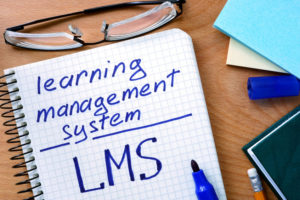Note: The contents of this post – and more – have also been covered in an episode of the Leading Learning podcast.
What kind of return on investment will we get from implementing a new or replacement learning management system (LMS)?
Sometimes, organizations get bogged down with answering this question and spend way too much time and – in some cases – money searching for a precise answer. Analysis paralysis sets in.
Other times, unfortunately, we discover it has not been asked at all before proceeding with licensing and implementation of an expensive solution.
Sanity, as is so often the case, lies somewhere in between. Here are five factors to consider and try – within reason – to answer before signing on the dotted line for a learning management system.
New Revenue Generation
How directly will the LMS support the creation and delivery of new products or enhance the revenue potential of existing products?
At a minimum, an LMS should enable you to increase the reach of your educational offerings, both in quantity and depth. That is, you should be able to connect with more learners, and for the learners you already serve, you should be able to engage them with additional options. While it is impossible to know the exact revenues associated with this increased reach, you should be able to make some educated guesses.
How many of your members, for example, are you currently not reaching with any of your current educational offerings? What if there was an online version, for example, of one of your more popular face-to-face offerings? Surely you could reach at least five percent of the potential audience you are not currently reaching.
And, for those who are frequently attending you offerings – whether online or off – what spin-offs or related offerings could you create from your most popular offerings? Again, surely you can reach a percentage of this audience with new offerings.
Note that I’m advocating working with your most popular current content. Organizations often shy away from this approach thinking they need to reach new audiences with new products (one of the hardest ways to expand a business) or that they will “cannibalize” current face-to-face offerings if they offer online versions (we’ve never seen this happen – almost always the opposite).
Some key benefits of working with current, popular offerings are that (a) you have a reasonable idea of the untapped audience, (b) you have an existing pricing approach to leverage, (c) you usually have a good idea of what is driving demand, making it much clear how to position and promote the new offerings. With this information in hand, making some conservative, educated guesses about potential revenue is not all that hard. Fire up an Excel spreadsheet and run the numbers for the next 3 years.
Cost Savings
In addition to any new revenue potential, what cost savings will putting an LMS in place make possible?
While putting an LMS in place – or switching to a new one – will certainly create some costs, it should also lead to productivity increases that ultimately decrease costs.
In some cases, the cost decrease may be relatively small. One recent client calculated an annual savings of approximately $3K, based on the reduced amount of time staff would likely need to spend handing requests for processing CE.
On the other hand, the decrease can be quite large: another organization calculated savings of $65K per year based on reduced staff time and mailing costs related to processing and issuing certificates. These saving alone were enough to justify implementation of an LMS, even though the organization was not projecting new revenue to materialize any time soon.
As these examples suggest, an LMS is not just about courses, it’s about managing learning, and that generally includes credits and certificates. At a higher level, it is about operational efficiency, and operational efficiency pretty much always produces cost savings. So, take a hard look at where your costs – particularly labor costs – are with respect to the delivery and management of education, determine the efficiencies an LMS could help create, and make some conservative estimates of the associated dollar figures.
General Value Perception
If you implement a first or a replacement LMS, to what extent will this increase your current members’ perception of the value you provide as an organization? To what extent might it help you attract new members? To what extent may it elevate your overall brand as an important contributor to your field or industry?
To get at answers to these questions, you usually need to ask some other questions first.
For example, how much use are your members or potential members currently making of e-learning? From what sources? Are they getting enough of the right types of e-learning? Are there segments that are being significantly under-served? This is data that can be (though, in our experience, usually isn’t) gathered through properly crafted survey questions.
If it is clear that key parts of your audience are making significant use of e-learning from sources other than your organization, then you have a clear opportunity for elevating value perception by providing new options that align with learner needs.
Additionally, using the LMS to deliver educational content in support of critical strategic initiatives can also significantly elevate value perception. If, for example, your organization has determined in must better support the pipeline of future workers into your industry, the delivery of online education to support a certification, assessment-based certificate, or series of digital badges may be a very powerful tactic.
A note of caution: Many organizations tell us they need to implement an LMS and start delivering online education simply so that they will be perceived as keeping up with the times. If that is the main driver for implementing an LMS, don’t do it. Revisit the points above and put the work into figuring our more tangible types of return.
User Experience
How will implementing an LMS improve the overall experience learners have with our educational offerings? How will it help our offerings be more impactful – and how will we know?
While closely related to the value perception question above, user experience deserves to be considered on its own. If you are seeking to provide a better user experience, make sure you know your starting point. Don’t just rely on opinion and anecdotes, even though there are likely to be plenty of those flying around. Instead, make use of services like UserTesting.com and UsabilityHub to actually test and gather useful data about the experience you are currently providing.
If you know your starting point, then you will be able to craft the most compelling vision possible for where how much you can realistically improve upon the current experience. You will also know where improvement is most needed, helping ensure that you will ultimately invest in the right features and functionalities to improve experience.
And, of course, this is an area you will want to return to. If you clearly establish a benchmark through testing, you will be able to repeat testing over time to see how you are actually performing against the benchmark. A novel idea, I know, but one that can clearly establish whether or not an LMS is producing the desired return.
Fulfillment of Mission and Vision
How will implementing a new or replacement LMS contribute to fulfilling the mission and vision of the organization?
While this may seem like a difficult question to answer in a measurable way, definitely don’t ignore it. It speaks directly to the responsibility of board members – often the people who are going to have to approve the budget for an initial or replacement LMS.
Generally speaking, to the extent that you are elevating value perception, improving user experience, and supporting a financially sustainable approach to delivering education, you are helping to fulfill mission and vision. So, you are already well on your way with the above points – and these are, of course, measurable points.
Keep in mind that, when it comes to mission and vision, reach and impact are usually critical. If an LMS enables you to reach many more people across your field or industry with useful learning experiences – even ones that you do not charge for – that would contribute to mission and vision for pretty much any organization I have ever encountered. And, of course, reach can be measured.
If you are able to show that you are actually having an impact with the learning experiences you deliver through the LMS – that is, actually changing the field for the better by elevating knowledge, skills, and behavior – well then, dear reader, you are a learning leader, and someone better be processing your promotion papers.
An LMS alone, of course, will not achieve this. Any learning management system is ultimately only as good as the learning experiences it supports – which must be expertly designed and facilitated – but capturing the data that shows impact, particularly through thoughtful assessment strategies, should be a strength of any well-designed LMS. You just need to know what kind of data will demonstrate impact that aligns with mission and vision.
It All Comes Back to Strategy
Knowing what kind of of data will demonstrate impact that aligns with mission and vision is, of course, a direct outcome of having a solid strategy for your learning and education business.
When it comes right down to it, getting the highest possible return off of implementing an LMS starts with knowing clearly the strategy the LMS supports. This is why we start with clarifying strategic objectives in our 7-step LMS selection process. If you have your objectives solidly in place, however, the five points above will naturally flow from them – and you will be on the road to getting a high return off of your LMS investment.
Jeff
P.S. – If this post was of interest, you may also want to see:



Leave a Reply